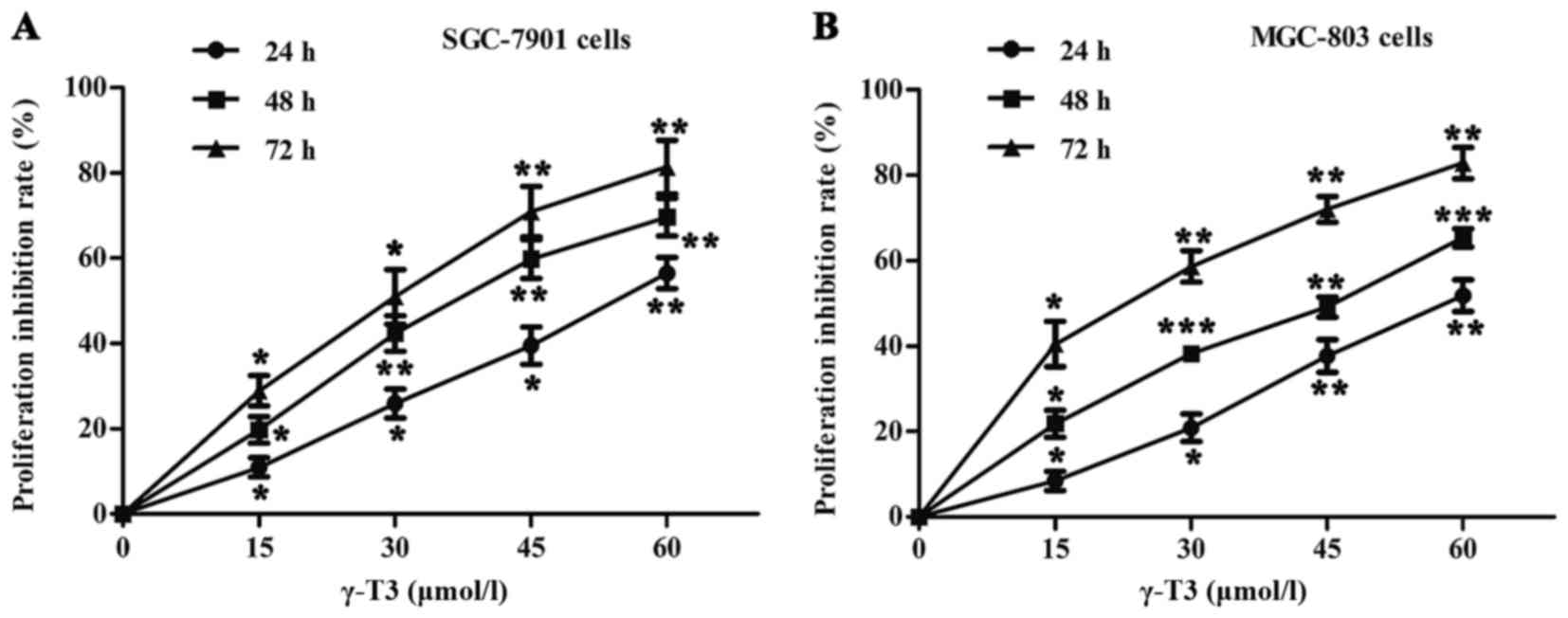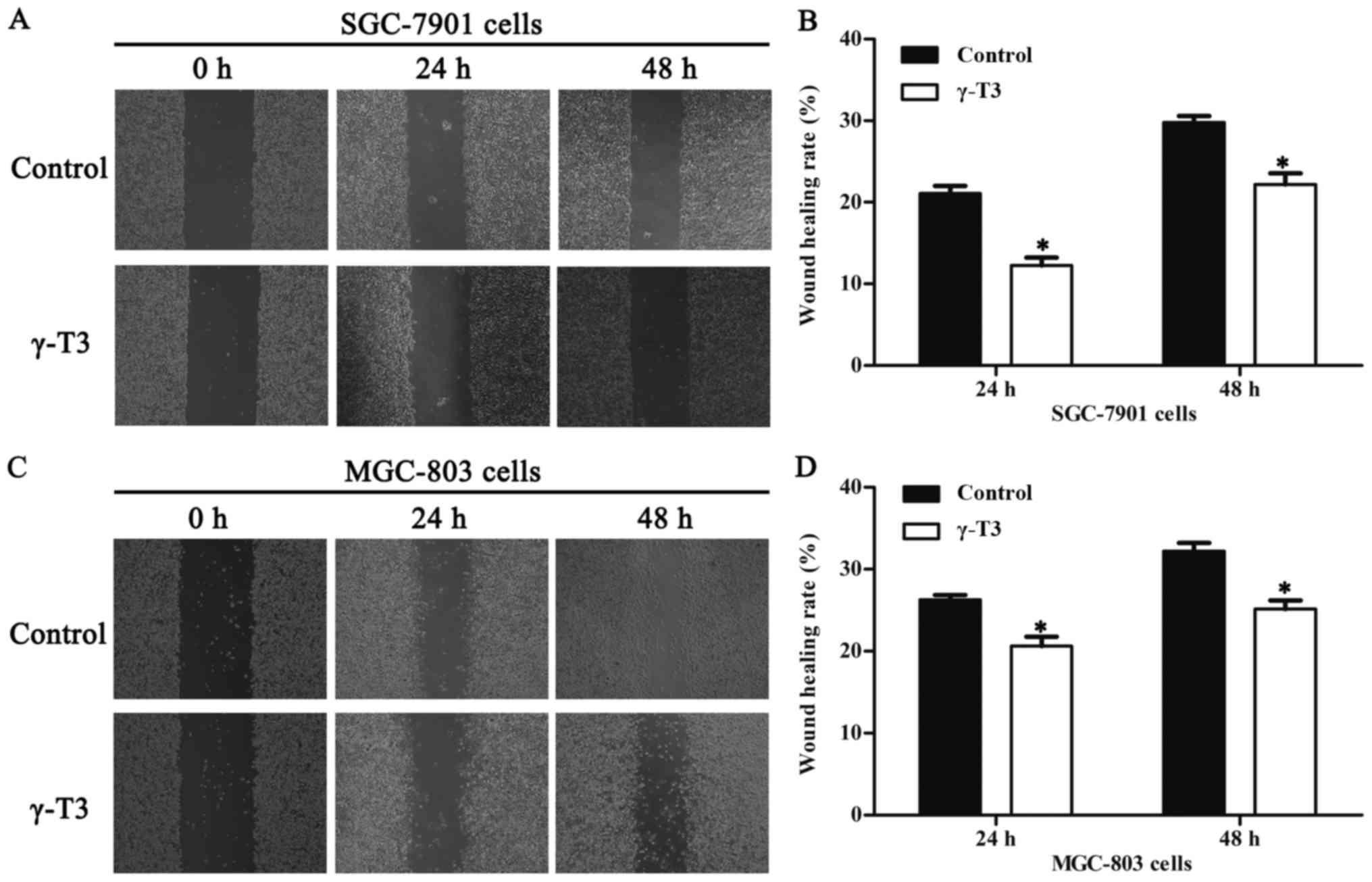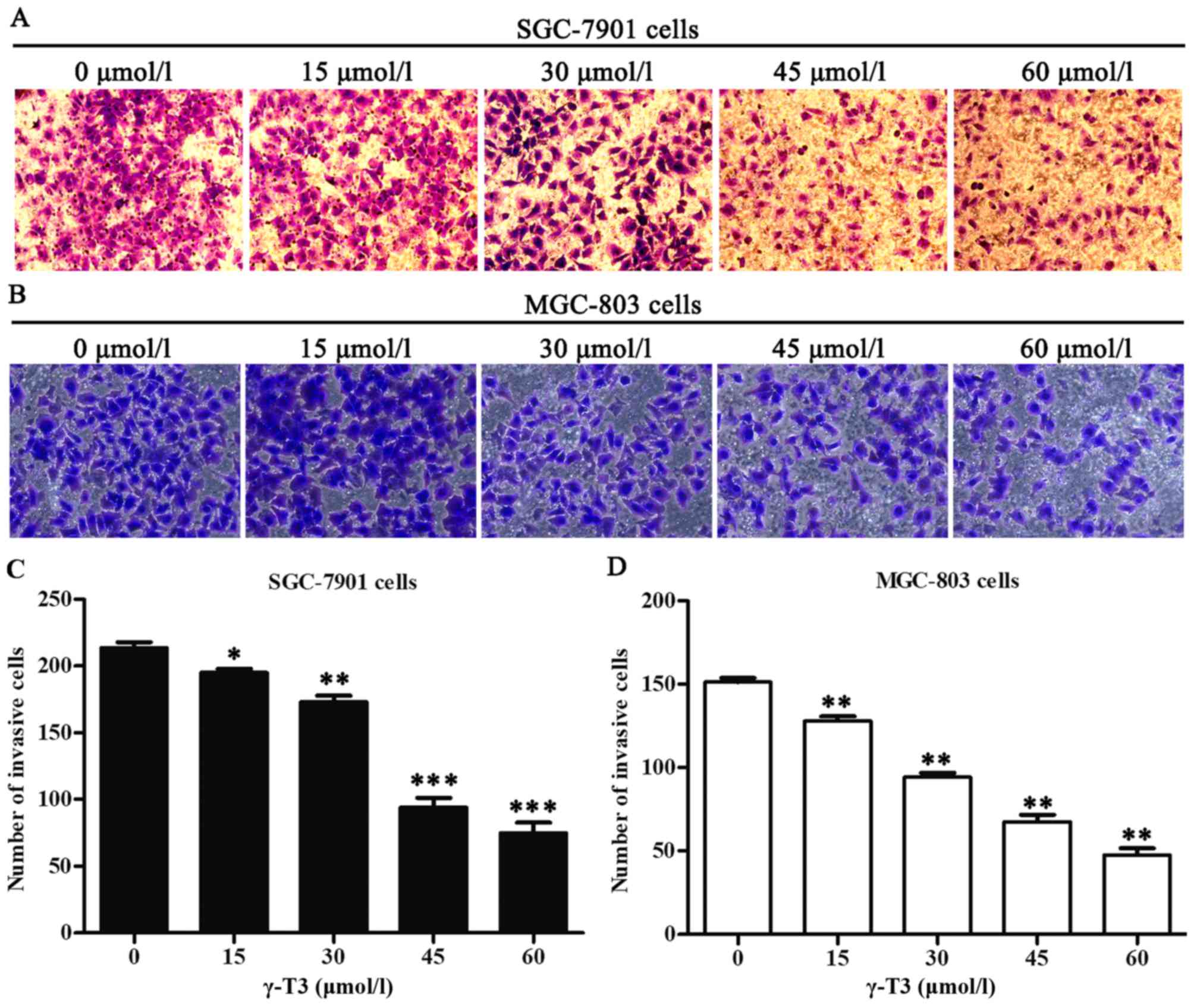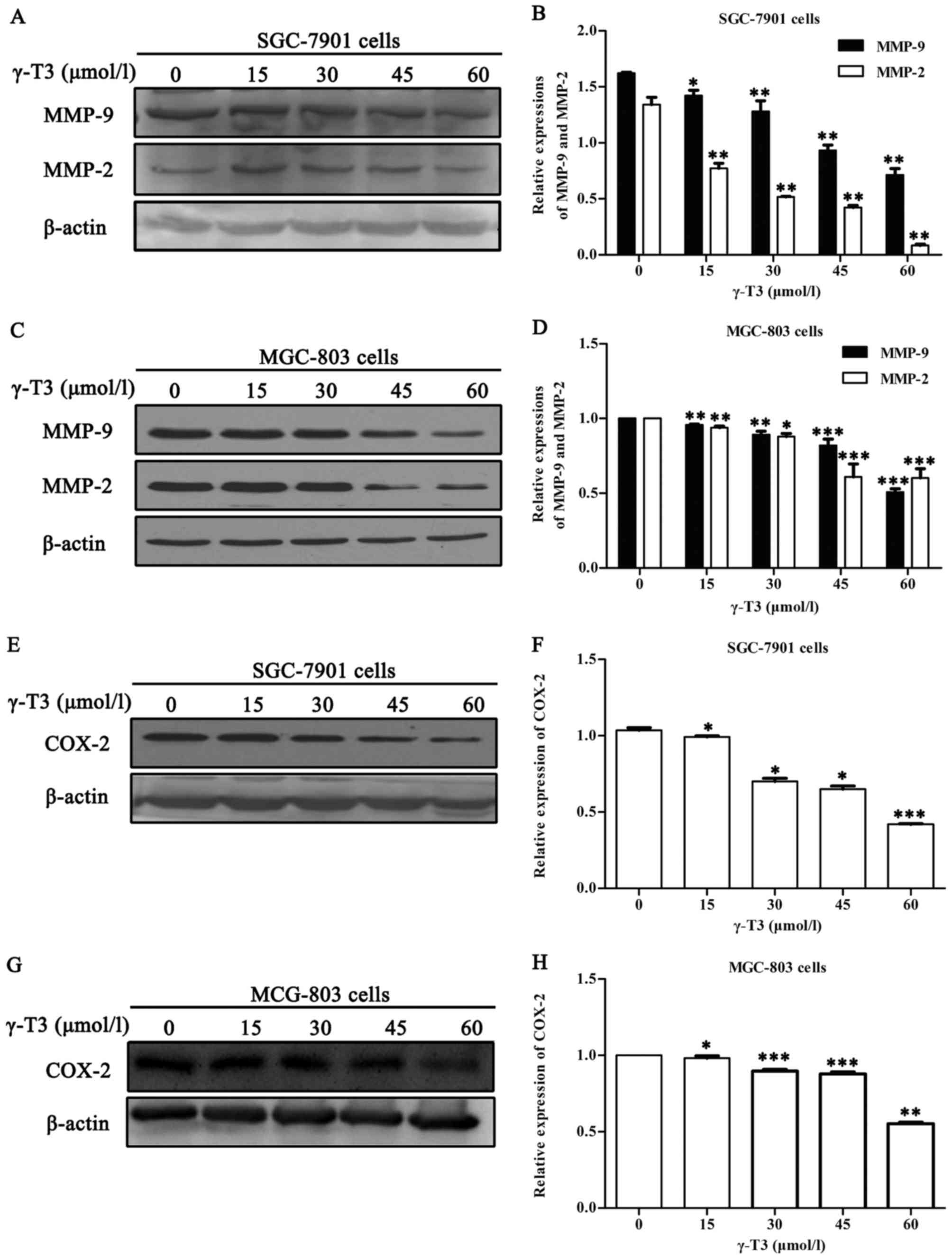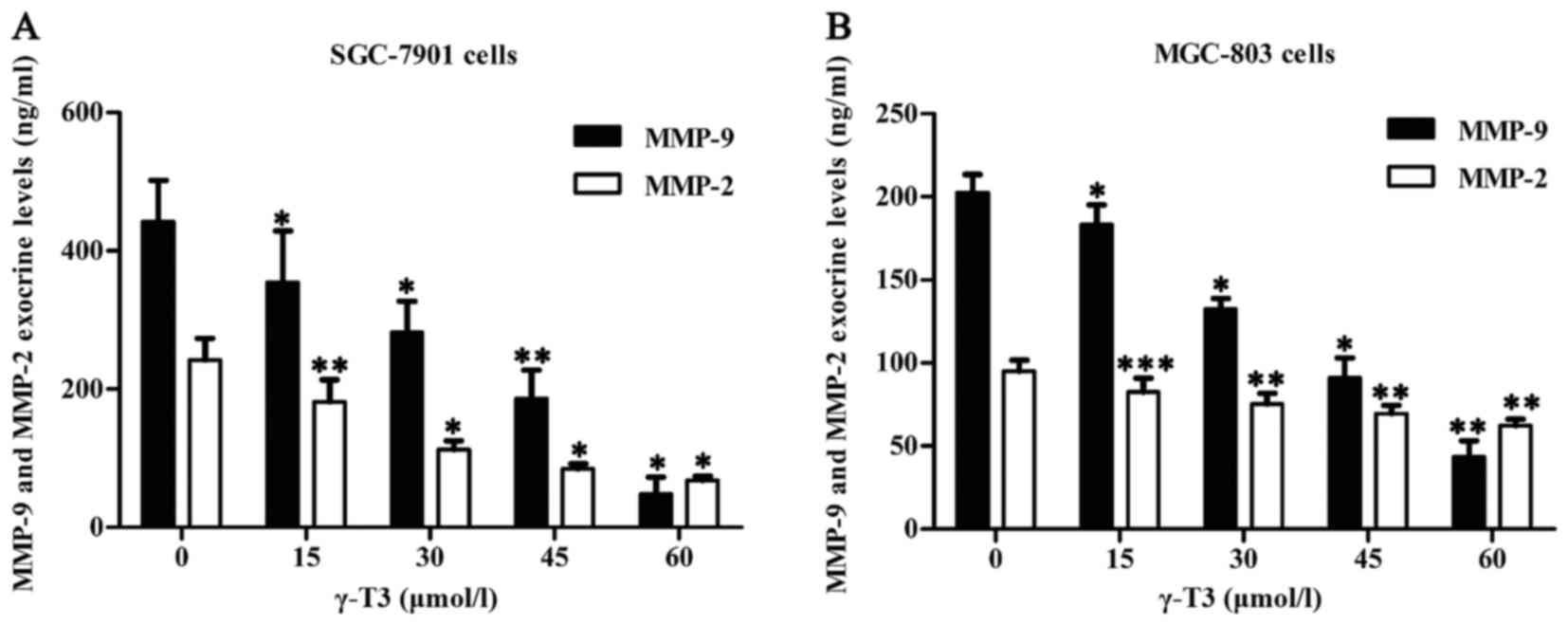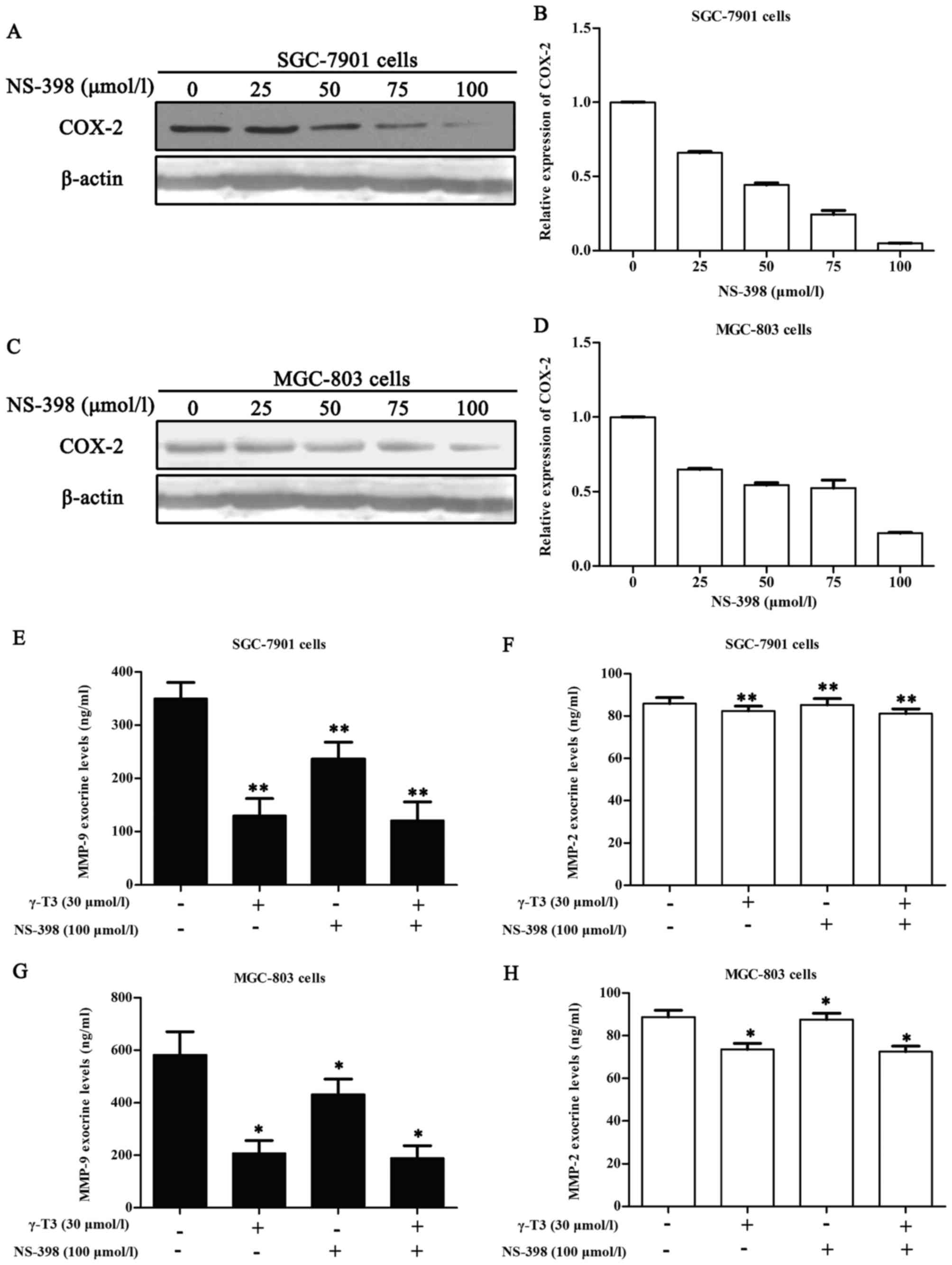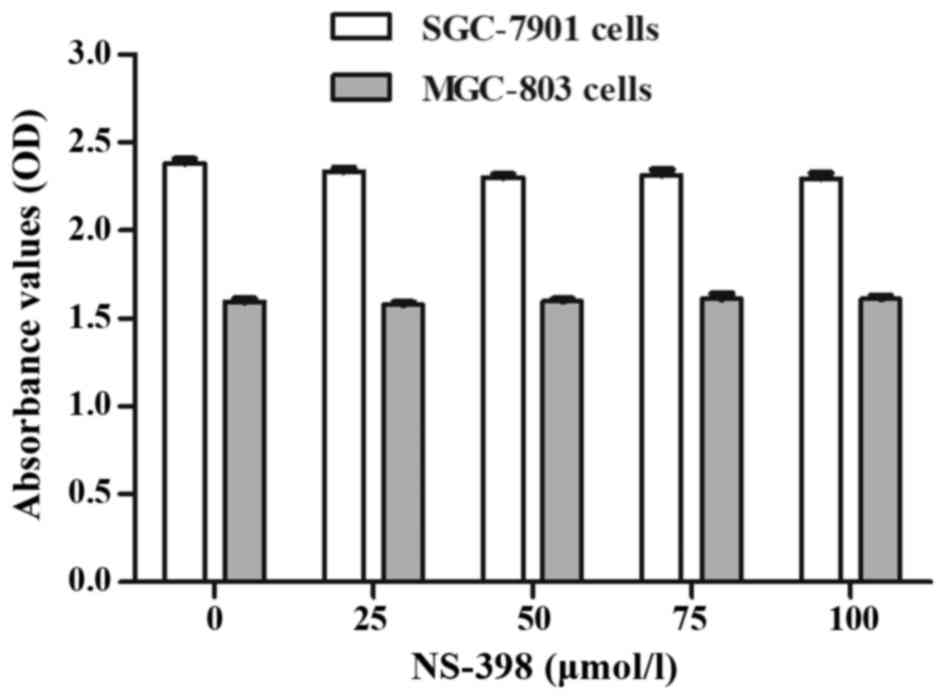γ-tocotrienol inhibits the invasion and migration of human gastric cancer cells through downregulation of cyclooxygenase-2 expression
- Authors:
- Published online on: June 14, 2018 https://doi.org/10.3892/or.2018.6497
- Pages: 999-1007
Abstract
Introduction
Gastric cancer is one of the most commonly diagnosed cancers worldwide (1,2). Currently, while radical surgery is the most common and effective treatment, the prognosis of patients with advanced gastric cancer following curative resection remains poor. The 5-year survival rate of patients with gastric cancer is 27.4% after surgical resection (3). There is no denying that proliferation, invasion and metastasis of cancer cells lead to poor prognoses, which presents therapeutic challenges. The major causes of death for gastric cancer patients are liver metastases and peritoneal metastases (4). Prevention of tumour recurrence and metastasis must urgently be improved. Available evidence has demonstrated that certain nutrients and non-nutrients derived from foods, such as phytochemicals (4–8) and vitamins (9–11), have protective effects against cancer.
Consumption of vitamin E, one of the most widely consumed vitamins, is prevalent because of its antioxidant capacity and multiple health benefits. Tocotrienols, isoforms of the vitamin E family, can be derived from several plant species, including palm oil, wheat germ, barley and bran oil. It should be noted that the antitumour properties of vitamin E (8–10) have been a hot topic in recent years, which may make tocotrienols a promising group of drugs for future development (12,13).
Cyclooxygenase-2 (COX-2), an important isoform of the COX family, is well known for its close relationship to tumourigenesis, invasiveness, inflammatory response, angiogenesis and tumour cell growth (14). It has been reported that COX-2 is continuously expressed and is closely associated with the invasiveness and metastasis of gastric cancer cells (15). COX-2 promotes the development and metastasis of gastric cancer cells. Furthermore, there are several other types of tumours in which COX-2 is highly expressed, such as oesophageal, liver, lung and breast cancer, as well as other gastrointestinal cancers (16–20).
Matrix metalloproteinases (MMPs) can degrade nearly all types of ECM proteins, and they destroy histologic barriers during the processes of invasion and metastasis (15). In addition, MMP-9 and MMP-2 have been reported to be overexpressed and associated with tumour migration and invasion (21,22). Notably, there is an intimate connection between MMPs and the mechanism by which COX-2 regulates tumour metastasis (15).
Although recent studies have revealed that γ-T3 displays inhibitory effects on the migration and invasion of human gastric cancer cells, the specific mechanism remains unclear (9). Our present study demonstrated that compared to γ-T3 alone, combination of γ-T3 and N-[2-(cyclohexyloxy)-4-nitropheny]-methane sulphonamide (NS-398, a highly selective inhibitor of COX-2) did not significantly alter the exocrine levels of MMP-2 and MMP-9 in gastric adenocarcinoma cell lines. Thus, it was concluded that the reduction of COX-2 resulting from γ-T3 was likely to be the cause that inhibited the invasion and migration of SGC-7901 and MGC-803 cells.
Materials and methods
Chemicals and cell lines
γ-Tocotrienol (γ-T3) (≥97%) was purchased from Hygeia Industries Inc. (Wilmette, IL, USA). γ-T3 was dissolved in ethanol (95%) to produce a 104 µmol/l solution and was stored at −20°C. A Cell Counting Kit-8 (CCK-8) was purchased from Dojindo Molecular Technologies, Inc. (Kumamoto, Japan). RPMI-1640 medium, fetal bovine serum (FBS), 0.25% EDTA and penicillin/streptomycin were purchased from Gibco; Thermo Fisher Scientific, Inc. (Waltham, MA, USA). anti-COX-2 (1:1,000; cat. no. 4842), anti-MMP-2 (1:1,000; cat. no. 4022), anti-MMP-9 (1:1,000; cat. no. 3852) and anti-β-actin antibodies, along with NS-398, were purchased from Cell Signaling Technology Inc. (Danvers, MA, USA). NS-398 was prepared in a range of concentrations.
Cell culture
Human gastric cancer cell lines SGC-7901 and MGC-803 were purchased from the Cancer Institute of the Chinese Academy of Medical Sciences (Beijing, China). The two cell lines were cultured at 37°C in a 5% CO2 incubator in 100-mm culture dishes with RPMI-1640 medium supplemented with 10% FBS and 1% penicillin/streptomycin. Upon reaching ~70–80% confluence, the cells were trypsinized using a mixture of 0.25% trypsin and EDTA, and then logarithmic phase cells were selected for subsequent experiments.
CCK-8 assay
The proliferation of SGC-7901 and MGC-803 cells treated with various concentrations of γ-T3 or NS-398 was detected by CCK-8 assays. Briefly, 1×104 cells/well (100 µl) were seeded in 96-well microtiter plates. After incubation overnight, the cells were changed to fresh culture medium (2% FBS) containing 0, 15, 30, 45 and 60 µmol/l of γ-T3, or 0, 25, 50, 75 and 100 µmol/l NS-398. After incubation for 24, 48 or 72 h, 10 µl of CCK-8 was added to each well. After incubating for another 4 h, the absorbance values in each well were measured at a wavelength of 450 nm on a microplate reader (ELx800; BioTek Instruments, Inc., Winooski, VT, USA). Cell viability was assessed with blank controls as 100% to calculate the percentage of control.
Scratch wound healing assay
SGC-7901 or MGC-803 cells were seeded in 6-well plates at 5×105 cells/well overnight in a humidified incubator with an atmosphere of 5% CO2 at 37°C. After pretreatment with 30 µmol/l of γ-T3 for 24 h, a sterile 200 µl Eppendorf tip was used to scratch the cells in the plates, which were then washed with PBS three times and placed in fresh serum-free RPMI-1640 medium for 24 and 48 h. The distance of wound healing was recorded. Three random fields were selected for examination and were photographed with an inverted microscope (magnification, ×100).
Transwell invasion assay
Cell invasion assays were conducted in Transwell chambers (Corning, Acton, MA, USA) with 8-µm pores containing Matrigel in a 24-well plate, as previously described (23). Briefly, SGC-7901 or MGC-803 cells were treated with γ-T3 (0, 15, 30, 45 and 60 µmol/l) for 24 h and were then trypsinized and resuspended in serum-free RPMI-1640 medium. The cells were added into the upper chamber at 2×105 cells/well in 200 µl serum-free RPMI-1640 medium. RPMI-1640 medium containing 10% FBS (500 µl) was added into the lower chamber. After incubation for 48 h, the non-invasive cells in the inside membrane of the chamber were scraped off with a sterile cotton swab. The cells in the outer membrane of the chamber, which had passed through the Matrigel, were washed three times with PBS, fixed with 4% formaldehyde for 20 min and stained with crystal violet for 20 min. Cells located on the underside of the filter were photographed and counted with an inverted microscope (magnification, ×200). The results were expressed as the number of cells that had invaded through the Matrigel within each field.
Western blot analysis
To determine the levels of COX-2, MMP-2 and MMP-9 protein expression, total protein was extracted from SGC-7901 and MGC-803 cells using cell lysis buffer containing protease inhibitors (both from Cell Signaling Technology, Inc.). Total protein determination and gel electrophoresis were performed as described in our previous studies (24). The blots were incubated with anti-COX-2 (1:1,000; cat. no. 4882) anti-MMP-2 (1:1,000; cat. no. 4042), anti-MMP-9 (1:1,000; cat. no. 3852) or anti-β-actin primary antibodies, and goat anti-rabbit horseradish peroxidase (HRP) secondary antibodies (1:8,000; cat. no. A9169) (Sigma-Aldrich, St. Louis, MO, USA). Target protein bands in membranes were visualized using enhanced chemiluminescence (Thermo Fisher Scientific, Inc.). The relative expression of the three aforementioned proteins was assessed using β-actin as an internal standard.
Enzyme-linked immunosorbent assay (ELISA)
To further determine whether γ-T3, NS-398 or γ-T3 combined with NS-398 inhibited exocrine functions of MMP-9 and MMP-2 in SGC-7901 and MGC-803 cells, culture supernatants were examined using ELISA assays. Supernatants were collected from SGC-7901 and MGC-803 cells after treatment with γ-T3 (0, 15, 30, 45 or 60 µmol/l), NS-398 (100 µmol/l) or γ-T3 combined with NS-398 (30 and 100 µmol/l, respectively) for 24 h. The concentrations of MMP-9 and MMP-2 in the supernatants were detected according to the ELISA kit protocol. Optical density values were acquired using a microplate reader. Final values were calculated by subtracting the optical density at 570 nm from that at 450 nm. Each sample was assessed at least three times. Concentrations of MMP-9 and MMP-2 were calculated with a standard curve.
Statistical analysis
All experiments were independently performed at least three times, and data were expressed as the means ± SD. Differences between γ-T3-treated and control groups were analysed using Student's t-test or one-way analysis of variance (ANOVA) followed by Dunnett's post hoc test using SPSS 16.0 (SPSS, Inc., Chicago, IL, USA) and GraphPad Prism 5.0 (GraphPad Software, Inc., La Jolla, CA, USA). The grey values of protein bands were analysed by ImageJ software. Differences were considered statistically significant at P<0.05.
Results
γ-T3 inhibits the proliferation of SGC-7901 and MGC-803 cells
As shown in Fig. 1, the rates of cell proliferation were determined by CCK-8 assays in SGC-7901 and MGC-803 cells. γ-T3 significantly inhibited the proliferation of SGC-7901 and MGC-803 cells treated with different concentrations of γ-T3 (0, 15, 30, 45 or 60 µmol/l) in a time- and dose-dependent manner (P<0.05, P<0.01 and P<0.001, respectively) (Fig. 1). The IC50 values were also calculated for cells treated with γ-T3 for 24, 48 or 72 h (Table I).
γ-T3 inhibits the migration and invasion of SGC-7901 and MGC-803 cells
According to the IC50 values, 30 µmol/l of γ-T3 evidently did not affect proliferation of these cells. Consequently, 30 µmol/l γ-T3 was chosen to test cell migration in wound healing assays. The results revealed that γ-T3 notably inhibited the migration ability of SGC-7901 and MGC-803 cells after treatment for 24 and 48 h compared with that of the control group (P<0.05, Fig. 2). To analyse the effects of γ-T3 on gastric cancer cell invasion, the Transwell chamber assay was also employed for this experiment. The invasive ability of SGC-7901 and MGC-803 cells was quantified as the number of tumour cells passing through the microporous membrane. γ-T3 significantly decreased the number of invasive cells (P<0.05, P<0.01 and P<0.001; Fig. 3), which indicated that γ-T3 inhibited the invasion of gastric cancer cells.
γ-T3 inhibits the expression of COX-2, matrix metalloproteinases-2 and −9 (MMP-2 and MMP-9) in SGC-7901 and MGC-803 cells
To assess the effects of γ-T3 on the expression of COX-2, MMP-2 and MMP-9, western blot analyses were performed with proteins from SGC-7901 and MGC-803 cells treated with different concentrations of γ-T3 for 24 h. As shown in Fig. 4, γ-T3 significantly decreased the expression of COX-2, MMP-2 and MMP-9 in gastric cancer cells in a dose-dependent manner (P<0.05 or P<0.01 and P<0.001).
γ-T3 inhibits exocrine levels of MMP-2 and MMP-9 in SGC-7901 and MGC-803 cells
To further detect exocrine levels of MMP-2 and MMP-9, cell supernatants were explored by ELISA. The results revealed that γ-T3 significantly inhibited secretion of MMP-2 and MMP-9 in SGC-7901 and MGC-803 cells (P<0.05 or P<0.01 and ***P<0.001) (Fig. 5). Thus, γ-T3 inhibited not only intracellular expression of MMP-2 and MMP-9, but also secretion of MMP-2 and MMP-9 in SGC-7901 and MGC-803 cells.
γ-T3 (30 µmol/l) combined with NS-398 (100 µmol/l) does not significantly alter the exocrine levels of MMP-9 and MMP-2 in SGC-7901 and MGC-803 cells
In light of the aforementioned data, we utilized ELISA assays to further investigate whether γ-T3 could affect the exocrine levels of MMP-9 and MMP-2 in SGC-7901 and MGC-803 cells when combined with 100 µmol/l NS-398. This concentration of NS-398 maximized the inhibitory effect on COX-2 (Fig. 7A and C) and did not have adverse effects on the cells according to the instructions and the CCK-8 assay (Fig. 6). In addition, 30 µmol/l γ-T3 in 24 h had no evident actions on the proliferation of SGC-7901 and MGC-803 cells (Table I). Thus, we selected 100 µmol/l NS-398 to ascertain whether combination with 30 µmol/l γ-T3 affected the exocrine levels of MMP-9 and MMP-2 in SGC-7901 and MGC-803 cells. Compared to the control, the 30 µmol/l γ-T3 group, 100 µmol/l NS-398 group, and 30 µmol/l γ-T3 + 100 µmol/l NS-398 group exhibited a significant declining trend (P<0.05 or P<0.01). However, compared to the 30 µmol/l γ-T3 group alone, the 30 µmol/l γ-T3 + 100 µmol/l NS-398 group exhibited no statistical significance (P>0.05).
Discussion
Gastric cancer is the second leading cause of malignant tumours worldwide (25). Chemotherapy is an important treatment method, but it frequently leads to poor effects or failure due to multidrug resistance (MDR). As a result, the discovery of novel therapeutic methods to solve these problems is extremely urgent. Furthermore, since invasion and metastasis are two important characteristics that can determine the effects of cancer diagnosis and prognosis (26), it has become crucial to take effective measures to increase prevention of gastric cancer.
γ-T3, a member of the vitamin E family, has been demonstrated to inhibit proliferation and induce apoptosis, as well as exhibit superior inhibition of migration and invasion in tumour cells (8,9). These antitumour properties explain why γ-T3 has received so much attention in recent years. In this study, we also obtained evidence that γ-T3 inhibits the invasion and migration of human gastric cancer cells.
COX-2 is an induced form of cyclooxygenase that is often elevated in cancerous tissues (27). It is well known for accelerating the invasion and migration of tumour cells, making it a research hot topic in recent years (28). Recent studies have confirmed that COX-2 plays an important role in the invasion and metastasis of gastric cancer cells, and it has been suggested that reducing the expression of COX-2 in tumour cells may attenuate invasion and metastasis (29,30).
MMP-9, also known as 92-kDa type IV collagenase, is an enzyme belonging to the family of zinc-metalloproteinases. MMP-9 is involved in the breakdown of the extracellular matrix in normal physiological processes, such as angiogenesis, wound healing and cell migration, as well as in metastasis. MMP-2, also known as 72-kDa type IV collagenase and gelatinase A, is associated with processes such as cancer progression, cancer cell invasion, cell signalling, neovascularization and lymphangiogenesis. Metastasis and invasion are among the leading causes of death among gastric cancer patients (31). MMPs can be activated to destroy the basement membrane, resulting in the degradation of the extracellular matrix, thus opening channels for invasion and metastasis (15,32).
Both SGC-7901 (moderately differentiated) and MGC-803 (undifferentiated or poorly differentiated) belong to gastric adenocarcinoma cell lines. COX-2 can be expressed in the two cell lines, and the level of COX-2 in SGC-7901 cells is higher than in MGC-803 cells (33,34). In the present study, scratch wound healing and Transwell invasion assays demonstrated that γ-T3 treatment markedly inhibited the migration and invasion of SGC-7901 and MGC-803 cells (Figs. 2 and 3). Western blot analyses in the present study revealed that the expression of COX-2 and intracellular MMPs was decreased (Fig. 4). ELISA data revealed that the exocrine concentrations of MMPs in cell culture supernatants also exhibited a decreasing trend after SGC-7901 and MGC-803 cells were pretreated with γ-T3 for 24 h (Fig. 5). Notably, it has been revealed that overexpression of COX-2 is involved in the induction of MMPs (15). Thus, in light of our data, we speculated whether the decreases of COX-2 resulted in the exocrine levels of MMPs. Next, to determine whether these inhibitory effects on migration and invasion were associated with COX-2, we utilized NS-398 for verification. NS-398, a highly selective inhibitor of COX-2, was chosen for joint treatment with γ-T3, and the results were determined using ELISA assays. We noticed that the exocrine level of MMP-2 in Fig. 5A was higher than that in Fig. 7F. The cause of this is that cancer cells from different generations may exert different experimental outcomes. Compared to γ-T3 alone, γ-T3 in combination with 100 µmol/l NS-398 did not significantly alter the exocrine expression of MMP-9 and MMP-2 (P>0.05, Fig. 7). These findings indicated that the decrease in the exocrine levels of MMPs were likely to result from downregulation of COX-2, but the exact mechanism involved in the downregulation of MMPs by COX-2 remained unknown. The ELISA assay results were compatible with our hypothesis that the decreases of COX-2 were involved in the induction of MMPs in human gastric cancer cells. The data gathered in the present study suggest, at least in part, that the inhibitory effects on migration and invasion in treated SGC-7901 and MGC-803 cells (γ-T3 alone or combined with NS-398) may be associated with downregulation of COX-2.
In conclusion, the present study demonstrated that γ-T3 significantly inhibited migration and invasion of human gastric cancer cells via downregulation of COX-2 expression, making it a promising novel drug for future cancer treatment. The antitumour efficacy of γ-T3 may make a difference in the treatment and prevention of gastric cancer. Although we have explored the inhibitory potential of γ-T3 on migration and invasion in human gastric cancer cells in vitro, these experiments are insufficient to explain the mechanism by which γ-T3 acts. This drawback is also a limitation of our study that can be improved in future research. Accordingly, further research must be performed in mouse models in vivo to illustrate our results obtained in SGC-7901 and MGC-803 cells in vitro.
Acknowledgements
Not applicable.
Funding
The present study was supported by the National Natural Science Foundation of China (no. 81273061).
Availability of data and materials
The datasets used and analyzed during the current study are available from the corresponding author on reasonable request.
Authors' contributions
YHZ and KM carried out all the experiments and YHZ was responsible for drafing the manuscript. WGS was responsible for the study design. JRL, HXW, WXT and YHT were responsible for data collection and analysis. All authors read and approved the manuscript and agree to be accountable for all aspects of the research in ensuring that the accuracy or integrity of any part of the work are appropriately investigated and resolved.
Ethics approval and consent to participate
Not applicable.
Patient consent for publication
All authors carefully and critically reviewed the submitted manuscript and agreed to the final version for publication.
Competing interests
The authors declare that they have no competing interests.
Glossary
Abbreviations
Abbreviations:
|
γ-T3 |
γ-tocotrienol |
|
COX-2 |
cyclooxygenase-2 |
|
CCK-8 |
Cell Counting Kit-8 |
|
MMP-2 and MMP-9 |
matrix metalloproteinases-2 and −9 |
|
ELISA |
enzyme-linked immunosorbent assay |
References
|
Jemal A, Bray F, Center MM, Ferlay J, Ward E and Forman D: Global cancer statistics. CA Cancer J Clin. 61:69–90. 2011. View Article : Google Scholar : PubMed/NCBI | |
|
Torre LA, Bray F, Siegel RL, Ferlay J, Lortet-Tieulent J and Jemal A: Global cancer statistics, 2012. CA Cancer J Clin. 65:87–108. 2015. View Article : Google Scholar : PubMed/NCBI | |
|
Zeng H, Zheng R, Guo Y, Zhang S, Zou X, Wang N, Zhang L, Tang J, Chen J, Wei K, et al: Cancer survival in China, 2003–2005: A population-based study. Int J Cancer. 136:1921–1930. 2015. View Article : Google Scholar : PubMed/NCBI | |
|
Hu X: Risk factors and prognosis of liver metastasis from gastric cancer. Zhonghua Wei Chang Wai Ke Za Zhi. 17:108–111. 2014.(In Chinese). PubMed/NCBI | |
|
Chen HS, Liu M, Shi LJ, Zhao JL, Zhang CP, Lin LQ, Liu Y, Zhang SJ, Jin JC, Wang L, et al: Effects of raspberry phytochemical extract on cell proliferation, apoptosis, and serum proteomics in a rat model. J Food Sci. 76:T192–T198. 2011. View Article : Google Scholar : PubMed/NCBI | |
|
Dong HW, Zhang S, Sun WG, Liu Q, Ibla JC, Soriano SG, Han XH, Liu LX, Li MS and Liu JR: β-Ionone arrests cell cycle of gastric carcinoma cancer cells by a MAPK pathway. Arch Toxicol. 87:1797–1808. 2013. View Article : Google Scholar : PubMed/NCBI | |
|
Liu Q, Dong HW, Sun WG, Liu M, Ibla JC, Liu LX, Parry JW, Han XH, Li MS and Liu JR: Apoptosis initiation of β-ionone in SGC-7901 gastric carcinoma cancer cells via a PI3K-AKT pathway. Arch Toxicol. 87:481–490. 2013. View Article : Google Scholar : PubMed/NCBI | |
|
Liu Y, Liu M, Li B, Zhao JL, Zhang CP, Lin LQ, Chen HS, Zhang SJ, Jin JC, Wang L, et al: Fresh raspberry phytochemical extract inhibits hepatic lesion in a Wistar rat model. Nutr Metab (Lond). 7:842010. View Article : Google Scholar : PubMed/NCBI | |
|
Liu HK, Wang Q, Li Y, Sun WG, Liu JR, Yang YM, Xu WL, Sun XR and Chen BQ: Inhibitory effects of gamma-tocotrienol on invasion and metastasis of human gastric adenocarcinoma SGC-7901 cells. J Nutr Biochem. 21:206–213. 2010. View Article : Google Scholar : PubMed/NCBI | |
|
Zhang JS, Li DM, Ma Y, He N, Gu Q, Wang FS, Jiang SQ, Chen BQ and Liu JR: γ-Tocotrienol induces paraptosis-like cell death in human colon carcinoma SW620 cells. PLoS One. 8:e577792013. View Article : Google Scholar : PubMed/NCBI | |
|
Zhang JS, Zhang SJ, Li Q, Liu YH, He N, Zhang J, Zhou PH, Li M, Guan T and Liu JR: Tocotrienol-rich fraction (TRF) suppresses the growth of human colon cancer xenografts in Balb/C nude mice by the Wnt pathway. PLoS One. 10:e01221752015. View Article : Google Scholar : PubMed/NCBI | |
|
Ling MT, Luk SU, Al-Ejeh F and Khanna KK: Tocotrienol as a potential anticancer agent. Carcinogenesis. 33:233–239. 2012. View Article : Google Scholar : PubMed/NCBI | |
|
Gagic Z, Ivkovic B, Srdic-Rajic T, Vucicevic J, Nikolic K and Agbaba D: Synthesis of the vitamin E amino acid esters with an enhanced anticancer activity and in silico screening for new antineoplastic drugs. Eur J Pharm Sci. 88:59–69. 2016. View Article : Google Scholar : PubMed/NCBI | |
|
Liu B, Qu L and Yan S: Cyclooxygenase-2 promotes tumor growth and suppresses tumor immunity. Cancer Cell Int. 15:1062015. View Article : Google Scholar : PubMed/NCBI | |
|
Sun WH, Sun YL, Fang RN, Shao Y, Xu HC, Xue QP, Ding GX and Cheng YL: Expression of cyclooxygenase-2 and matrix metalloproteinase-9 in gastric carcinoma and its correlation with angiogenesis. Jpn J Clin Oncol. 35:707–713. 2005. View Article : Google Scholar : PubMed/NCBI | |
|
Huang JX, Xiao W, Chen WC, Lin MS, Song ZX, Chen P, Zhang YL, Li FY, Qian RY and Salminen E: Relationship between COX-2 and cell cycle-regulatory proteins in patients with esophageal squamous cell carcinoma. World J Gastroenterol. 16:5975–5981. 2010.PubMed/NCBI | |
|
Wu BW, Li DF, Ke ZF, Ma D, Li YJ, Gang D, Zheng ZG, Zhang KJ and Zhang YH: Expression characteristics of heparanase in colon carcinoma and its close relationship with cyclooxygenase-2 and angiogenesis. Hepatogastroenterology. 57:1510–1514. 2010.PubMed/NCBI | |
|
Krishnamachary B, Stasinopoulos I, Kakkad S, Penet MF, Jacob D, Wildes F, Mironchik Y, Pathak AP, Solaiyappan M and Bhujwalla ZM: Breast cancer cell cyclooxygenase-2 expression alters extracellular matrix structure and function and numbers of cancer associated fibroblasts. Oncotarget. 8:17981–17994. 2017. View Article : Google Scholar : PubMed/NCBI | |
|
Huang F, Lin C, Shi YH and Kuerban G: MicroRNA-101 inhibits cell proliferation, invasion, and promotes apoptosis by regulating cyclooxygenase-2 in Hela cervical carcinoma cells. Asian Pac J Cancer Prev. 14:5915–5920. 2013. View Article : Google Scholar : PubMed/NCBI | |
|
Li W, Sun D, Lv Z, Wei Y, Zheng L, Zeng T and Zhao J: Insulin-like growth factor binding protein-4 inhibits cell growth, migration and invasion, and downregulates COX-2 expression in A549 lung cancer cells. Cell Biol Int. 41:384–391. 2017. View Article : Google Scholar : PubMed/NCBI | |
|
Ram M, Sherer Y and Shoenfeld Y: Matrix metalloproteinase-9 and autoimmune diseases. J Clin Immunol. 26:299–307. 2006. View Article : Google Scholar : PubMed/NCBI | |
|
Nelson AR, Fingleton B, Rothenberg ML and Matrisian LM: Matrix metalloproteinases: Biologic activity and clinical implications. J Clin Oncol. 18:1135–1149. 2000. View Article : Google Scholar : PubMed/NCBI | |
|
Liu Z, Han L, Dong Y, Tan Y, Li Y, Zhao M, Xie H, Ju H, Wang H, Zhao Y, et al: EGFRvIII/integrin β3 interaction in hypoxic and vitronectinenriching microenvironment promote GBM progression and metastasis. Oncotarget. 7:4680–4694. 2016.PubMed/NCBI | |
|
Sun W, Wang Q, Chen B, Liu J, Liu H and Xu W: Gamma-tocotrienol-induced apoptosis in human gastric cancer SGC-7901 cells is associated with a suppression in mitogen-activated protein kinase signalling. Br J Nutr. 99:1247–1254. 2008. View Article : Google Scholar : PubMed/NCBI | |
|
Siegel R, Naishadham D and Jemal A: Cancer statistics for Hispanics/Latinos, 2012. CA Cancer J Clin. 62:283–298. 2012. View Article : Google Scholar : PubMed/NCBI | |
|
Liu W, Yang Q, Liu B and Zhu Z: Serum proteomics for gastric cancer. Clin Chim Acta. 431:179–184. 2014. View Article : Google Scholar : PubMed/NCBI | |
|
Li Z, You K, Li J, Wang Y, Xu H, Gao B and Wang J: Madecassoside suppresses proliferation and invasiveness of HGF-induced human hepatocellular carcinoma cells via PKC-cMET-ERK1/2-COX-2-PGE2 pathway. Int Immunopharmacol. 33:24–32. 2016. View Article : Google Scholar : PubMed/NCBI | |
|
Sun WH, Zhu F, Chen GS, Su H, Luo C, Zhao QS, Zhang Y, Shao Y, Sun J, Zhou SM, et al: Blockade of cholecystokinin-2 receptor and cyclooxygenase-2 synergistically induces cell apoptosis, and inhibits the proliferation of human gastric cancer cells in vitro. Cancer Lett. 263:302–311. 2008. View Article : Google Scholar : PubMed/NCBI | |
|
Zhang H, Sun K, Ding J, Xu H, Zhu L, Zhang K, Li X and Sun W: Harmine induces apoptosis and inhibits tumor cell proliferation, migration and invasion through down-regulation of cyclooxygenase-2 expression in gastric cancer. Phytomedicine. 21:348–355. 2014. View Article : Google Scholar : PubMed/NCBI | |
|
Sun K, Tang XH and Xie YK: Paclitaxel combined with harmine inhibits the migration and invasion of gastric cancer cells through downregulation of cyclooxygenase-2 expression. Oncol Lett. 10:1649–1654. 2015. View Article : Google Scholar : PubMed/NCBI | |
|
Shin NR, Jeong EH, Choi CI, Moon HJ, Kwon CH, Chu IS, Kim GH, Jeon TY, Kim DH, Lee JH, et al: Overexpression of Snail is associated with lymph node metastasis and poor prognosis in patients with gastric cancer. BMC Cancer. 12:5212012. View Article : Google Scholar : PubMed/NCBI | |
|
Velinov N, Poptodorov G, Gabrovski N and Gabrovski S: The role of matrixmetalloproteinases in the tumor growth and metastasis. Khirurgiia (Sofiia). 1:44–49. 2010.(In Bulgarian). | |
|
Liu XJ, Chen ZF, Li HL, Hu ZN, Liu M, Tian AP, Zhao D, Wu J, Zhou YN and Qiao L: Interaction between cyclooxygenase-2, Snail, and E-cadherin in gastric cancer cells. World J Gastroenterol. 19:6265–6271. 2013. View Article : Google Scholar : PubMed/NCBI | |
|
Jiang H, Zhou Y, Liao Q and Ouyang H: Helicobacter pylori infection promotes the invasion and metastasis of gastric cancer through increasing the expression of matrix metalloproteinase-1 and matrix metalloproteinase-10. Exp Ther Med. 8:769–774. 2014. View Article : Google Scholar : PubMed/NCBI |



